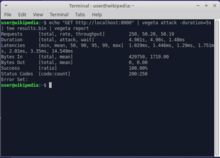Vegeta (software)
 Vegeta's reported results after being run to attack a server running on http://localhost:8000 for five seconds | |
| Original author(s) | Tomás Senart[1] |
|---|---|
| Initial release | August 13, 2013[2] |
| Stable release | 12.11.1[3] |
| Repository | github |
| Written in | Go[4] |
| Operating system | Linux, Microsoft Windows, macOS[1] |
| Type | HTTP Load testing |
| License | MIT License[1] |
| Website | pkg |
Vegeta is an
In addition to preemptive load testing, the program can also be used for shadow testing,[7] where traffic from a live version of an application is mirrored onto a test version to determine how it handles the same traffic load, without causing potential disruption to the live version of the application.[8] Shadow testing is done in this way in order to analyze anticipated server performance.[9]
Vegeta is provided for use by web hosting services such as Scaleway[4] to use varied and multiple requests to stress test client HTTP services.[10] It is also used with dedicated load-testing platform services such as BlazeMeter.[11]
Usage
The command-line usage is in the format of vegeta [global flags] <command> [command flags]. The three global flags are -cpus int which specifies the number of CPUs to use, -profile string which enables profiling, and -version which prints the software version and then terminates the program.[1]
The commands available are attack, encode, plot, and report, each with its own various command flag options, and both attack input and report output can be done in an optional JSON format when specified with the appropriate flag.[1]
Vegeta can specify targets as URLs in a separate file with optional custom headers and requests, which can then be used as an input option on the command line.[12]
Example
An example usage would be to issue echo "GET http://localhost/" | vegeta attack -duration=5s | tee results.bin | vegeta report from the command-line.[1] This example uses the echo command to output GET http://localhost/, and then executes the attack command for that output for five seconds. After that, it uses the tee command to write results to a file called results.bin, and runs the report command to display the output of the attack results.
References
- ^ a b c d e f Senart, Tomás (October 11, 2020). "GitHub - tsenart/vegeta: HTTP load testing tool and library. It's over 9000!". GitHub. Archived from the original on August 11, 2022. Retrieved August 27, 2022.
- ^ Senart, Tomás (August 13, 2013). "Initial commit". GitHub. Archived from the original on August 28, 2022. Retrieved August 27, 2022.
- ^ "Release v12.11.1".
- ^ a b c d "Load Testing with Vegeta". Scaleway. May 26, 2022. Archived from the original on October 16, 2021. Retrieved August 27, 2022.
- )
- )
- OCLC 1056157467.
- ^ "Application deployment and testing strategies". Google Cloud. February 5, 2020. Retrieved August 28, 2022.
- OCLC 1225562925. Archived from the original on August 28, 2022. Retrieved August 27, 2022.)
{{cite book}}: CS1 maint: location missing publisher (link - ^ Dumitrescu, Sorin (July 10, 2020). "Black Friday. 0 downtime. How Bunnyshell & Vegeta & UiPath can help". BunnyShell.com. Archived from the original on August 28, 2022. Retrieved August 27, 2022.
- ^ Levental, Alla (August 26, 2021). "Vegeta Load Testing". BlazeMeter. Archived from the original on August 28, 2022. Retrieved August 27, 2022.
- OCLC 1055162428. Archivedfrom the original on August 28, 2022. Retrieved August 27, 2022.
